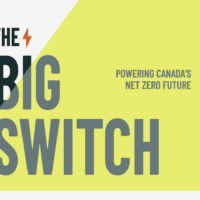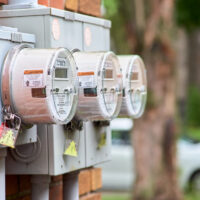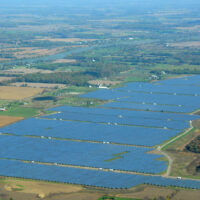Originally published by Policy Options.
The federal government has proposed a framework for clean electricity regulations that may not be consistent with its commitment of achieving net zero electricity by 2035. Clean electricity will power Canada’s net zero transition, enabling a “big switch” from fossil-fuel energy, which emits the heat-trapping gasses that cause climate change, to clean electricity. Clean electricity relies on sources like wind, solar and hydro.
However, the proposed standard would only deliver the clean electricity systems Canada needs under a specific set of design choices.
The 2035 target is necessarily ambitious. The federal government recognizes that Canada’s clean electricity production must increase significantly to meet our emissions reduction commitments in 2030 and 2050.
But with Canada batting zero on its past climate targets, it is critical we learn from previous failures and do what is required to meet that ambitious target. Humanity cannot afford more missed climate promises from countries like Canada.
A brief history of clean electricity
In 2021, the federal government commited to net zero electricity generation by 2035. This means that any remaining emissions of heat-trapping gasses would be offset by the capture and permanent storage of carbon in the atmosphere. This followed analysis and recommendations from Canadian researchers (including from co-author Mark Jaccard) and aligned with the policy direction of the United States government, which issued a similar target after determining its feasibility.
The Canadian government committed in its 2030 Emissions Reduction Plan, released earlier this year, to implement clean electricity regulations that would drive emissions down. Public consultations began in March with a discussion paper.
Following those consultations, the government laid out its framing of the proposed regulation. The specific regulations are still to come and would themselves go through a consultation process. But the newly released proposed framework sets out a direction that raises some substantial concerns.
Making clean electricity genuinely net zero
The first problem with the regulations is that after 2035, emissions that would be permitted would have to be offset by negative emissions (the net in net zero) or be subject to a financial compliance payment in line with the carbon price at the time.
This second option risks weakening the entire framework by greenlighting continued emissions, meaning a failure to hit Canada’s net zero electricity goal.
A Policy Options piece earlier this year argued that focusing on offsetting negative emissions would be the way to ensure power generation was genuinely net zero without creating risks for system reliability.
This regulation will fall under the Canadian Environmental Protection Act, which carries criminal liability for failing to meet its requirements. System operators might not be assured of their ability to successfully secure negative emissions. So having financial compliance as an alternative option can make sense. But it does not mean that the net zero target needs to be abandoned.
The federal government could commit to using the proceeds from financial compliance payments to purchase negative emissions on behalf of the sector. This would offer a way to make electricity generation genuinely net zero in a way that avoids putting utilities and system operators in a difficult legal position.
Get carbon pricing right
In its report Electric Federalism, the Canadian Climate Institute discusses the value of doing away with the output-based treatment that electricity currently gets in some provinces under the federal carbon price. (There can be good reasons to do output-based pricing, but most of them don’t apply to electricity.)
Carbon pricing could work effectively with the clean electricity regulations – and help avoid significant negative effects on electricity ratepayers – by instead applying the full carbon price to all electricity-related emissions and returning the revenue to ratepayers (to help keep electricity costs low).
However, the federal government’s proposed framework appears to be silent on these potential changes to carbon pricing. This raises the question of what kind of price signal the sector will get between now and 2035, when the federal performance standard takes effect.
Maintaining the current output-based approach will provide only a weak incentive for facilities to cut their emissions over the next decade. This could leave the sector poorly positioned to achieve net zero by 2035.
Instead, the government could do away with output-based pricing for electricity immediately. Or as we discuss in the Canadian Climate Institute’s formal response, it could remove electricity from federal carbon pricing altogether, and instead apply a price schedule under the regulations. This would create the added benefit of having the regulations drive emissions reductions in this decade, instead of well into the next.
Address affordability and equity directly – federally and provincially
The proposed framework seems to be strongly concerned with the effect that the policy could have on the price of electricity for a small percentage of consumers in just a few provinces in 2035. Concerns about affordability and equity are, of course, warranted, but they should not be used to justify less ambitious climate policy.
Instead, these challenges can be addressed directly, by bringing in new supports or strengthening existing ones. Indeed, provinces (through policies of their governments, utilities and utility regulators) commonly provide supports to low-income ratepayers already. Also, the Canadian government is providing support to households for efficiency improvements and heat pumps, and such support can be especially targeted to lower-income households and social housing.
The federal government made a commitment to have net zero electricity generation by 2035, and presumably it did so with some knowledge of what the costs and impacts could be. Concerns about affordability can and should be addressed directly through other policies and measures, rather than by reducing the stringency and effectiveness of this essential pillar of our national net zero commitment.
The path to net zero clean electricity
There is still a way to align this policy with Canada’s commitment to achieve net zero electricity generation by 2035. It requires the government committing to procuring negative emissions to offset any emissions from the sector post-2035, fixing the carbon price treatment the sector gets now, and addressing concerns about affordability and equity directly. In its 2030 Emissions Reduction Plan, Canada finally has a path to a policy framework for reaching our legislated emission reduction targets (see the Canadian Climate Institute’s independent assessment here). Staying on that path will require that it get this policy right.







